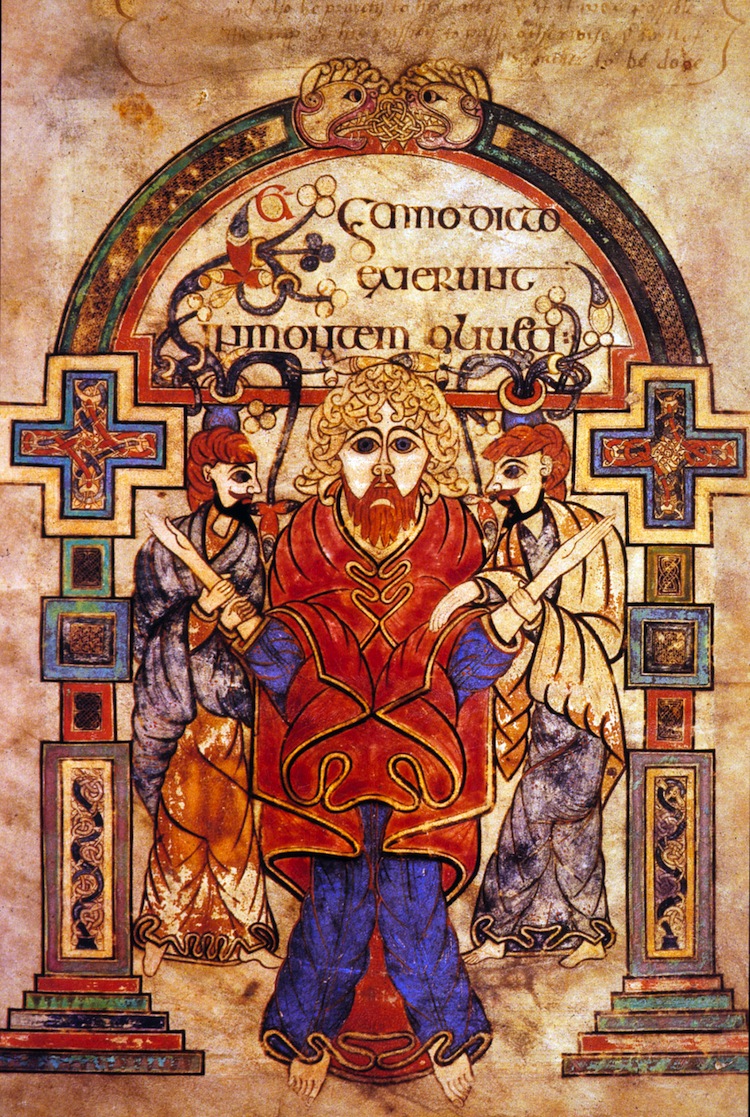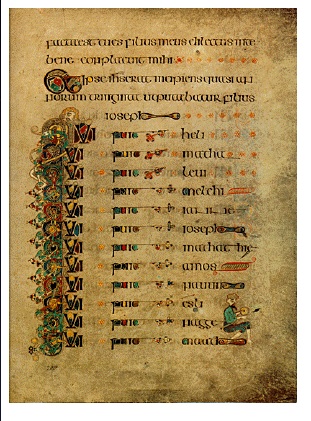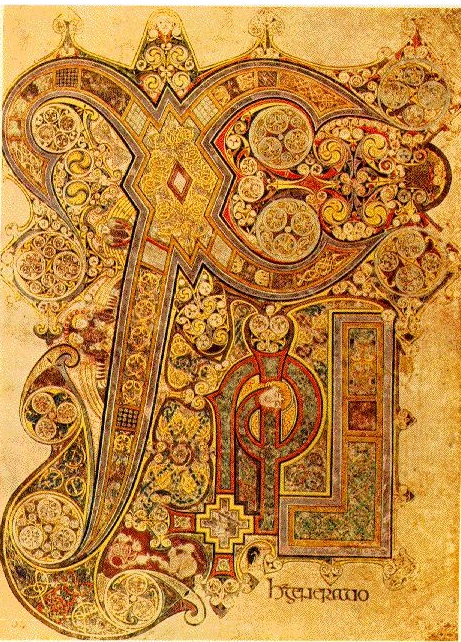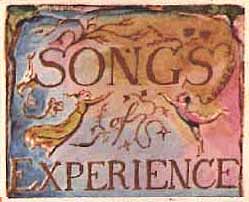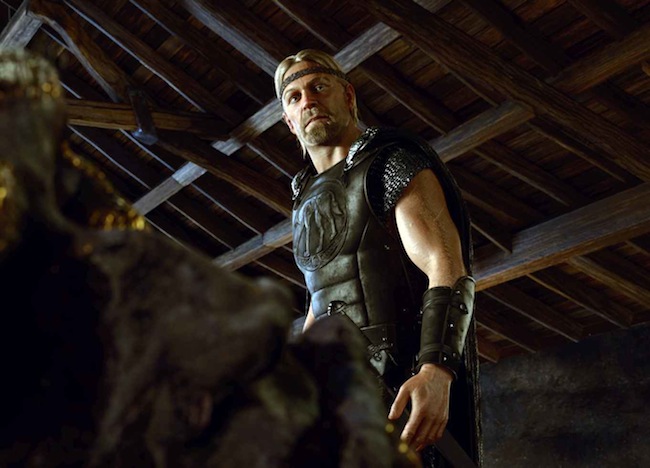This is the most recognized and most remarkable artifact of medieval Celtic art. It features page after page of lavish, colorful lettering, illumination, decoration and illustration. To a large extent, the great reputation which Celtic art and design have today is based on the exceptional quality of the images found in the Book of Kells.
An Irish manuscript containing the Four Gospels, a fragment of Hebrew names, and the Eusebian canons, known also as the “Book of Columba”. This is probably because it was written in the monastery of Iona to honour the saint. It is likely that it is to this book that the entry in the “Annals of Ulster” under the year 1006 refers, recording that in that year the “Gospel of Columba” was stolen.
According to tradition, the book is a relic from the time of Columba and even the work of his hands, but, on palæographic grounds and judging by the character of the ornamentation, this tradition cannot be sustained, and the date of the composition of the book can hardly be placed earlier than the end of the seventh or beginning of the eighth century. This must be the book which the Welshman, Geraldus Cambrensis, saw at Kildare in the last quarter of the twelfth century and which he describes in glowing terms (Topogr. Hibern., II, xxxviii).
We next hear of it at the cathedral of Kells (Irish Cenannus) in Meath, a foundation of Columba’s, where it remained for a long time, or until the year 1541. In the seventeenth century Archbishop Ussher presented it to Trinity College, Dublin, where it is the most precious manuscript in the collegelibrary and by far the choicest relic of Irish art that has been preserved. In it is to be found every variety of design typical of Irish art at its best.
Some small portions at the beginning and end of the manuscript have been lost, but otherwise it is in a very good state of preservation. It was apparently left unfinished, since some of the ornaments remain only in outline. It is written in part black, red, purple or yellow ink, and it has been thought that the hands of two scribes, neither of whom is known to us by name, are discernible in the writing and illumination of the manuscript. The most characteristic ornaments of the Book of Kells, as of other illuminated Irish manuscripts of the period, are the closely coiled spirals connected with each other by a number of curves and terminating in the so-called “trumpet pattern”.
Almost equally characteristic are the zoomorphic interlacements, coloured representations of fanciful beings, or of men, animals, birds, horses, dogs, and grotesque, gargoyle-like human figures, twisted and hooked together in intricate detail. Other frequently occurring designs are a system of geometrical weaving of ribbons plaited and knotted together, and a simpler ornamentation by means of red dotted lines. The versatility and inventive genius of the illustrator surpasses all belief. Lines diverge and converge in endless succession, and the most intricate figures, in lavish abundance and with astounding variety of ornament, are combined and woven into one harmonious design. In spite of the extent of the work and its thousands of exquisite initials and terminals, there is not a single pattern or combination that can be said to be a copy of another.
The artist shows a wonderful technique in designing and combining various emblems, the cross , vine, dragon, fish, and serpent. The drawing is perfection itself. It has been examined under a powerful magnifying glass for hours at a time and found to be, even in the most minute and complicated figures, without a single false or irregular line. Some of the most accomplished of modern draughtsmen have attempted to copy its elaborate designs, but, such is the delicacy of the execution, that they had to abandon the task as hopeless. In a space of one inch square were counted no less than 158 interlacings of white ribbon with a black border on either side. On the other hand, the pictures of the personages delineated are feeble and primitive and show but a limited knowledge of the human figure and its relative proportions.
No words can describe the beauty and the extreme splendour of the richly coloured initial letters, which are more profuse in the “Book of Kells” than in any other manuscript.
What is the Book of Kells?
The Book of Kells (Trinity College Dublin MS 58) contains the four Gospels in Latin based on the Vulgate text which St Jerome completed in 384AD, intermixed with readings from the earlier Old Latin translation. The Gospel texts are prefaced by other texts, including “canon tables”, or concordances of Gospel passages common to two or more of the evangelists; summaries of the gospel narratives (Breves causae); and prefaces characterizing the evangelists (Argumenta).
The book is written on vellum (prepared calfskin) in a bold and expert version of the script known as “insular majuscule”. It contains 340 folios, now measuring approximately 330 x 255 mm; they were severely trimmed, and their edges gilded, in the course of rebinding in the 19th century.
Where and when was the Book of Kells written?
The date and place of origin of the Book of Kells have attracted a great deal of scholarly controversy. The majority academic opinion now tends to attribute it to the scriptorium of Iona (Argyllshire), but conflicting claims have located it in Northumbria or in Pictland in eastern Scotland. A monastery founded around 561 by St Colum Cille on Iona, an island off Mull in western Scotland, became the principal house of a large monastic confederation. In 806, following a Viking raid on the island which left 68 of the community dead, the Columban monks took refuge in a new monastery at Kells, County Meath, and for many years the two monasteries were governed as a single community. It must have been close to the year 800 that the Book of Kells was written, although there is no way of knowing if the book was produced wholly at Iona or at Kells, or partially at each location.
Why is the Book of Kells famous?
The manuscript’s celebrity derives largely from the impact of its lavish decoration, the extent and artistry of which is incomparable. Abstract decoration and images of plant, animal and human ornament punctuate the text with the aim of glorifying Jesus’ life and message, and keeping his attributes and symbols constantly in the eye of the reader.
There are full pages of decoration for the canon tables; symbols of the evangelists Matthew (the Man), Mark (the Lion), Luke (the Calf) and John (the Eagle); the opening words of the Gospels; the Virgin and Child; a portrait of Christ; complex narrative scenes, the earliest to survive in gospel manuscripts, representing the arrest of Christ and his temptation by the Devil. The Chi Rho page (folio 34r), introducing Matthew’s account of the nativity, is the single most famous page in medieval art. There are portraits of Matthew and John, but no portrait of Mark or Luke survives. These were probably executed, like other major pages of the manuscript, on single leaves and they are presumed to have become detached over time and lost. In all, around 30 folios went missing in the medieval and early modern periods.
How many artists produced the Book of Kells?
Three artists seem to have produced the major decorated pages. One of them, whose work can be seen on the Chi Rho page, was capable of ornament of such extraordinary fineness and delicacy that his skills have been likened to those of a goldsmith. Four major scribes copied the text. Each displayed characteristics and stylistic traits while working within a scriptorium style. One, for example, was responsible only for text, and was in the habit of leaving the decoration of letters at the beginning of verses to an artist; while another scribe, who may have been the last in date, tended to use bright colours – red, purple, yellow – for the text, and to fill blank spaces with the unnecessary repetition of certain passages. The extent to which there was an identity between scribe and artist is among the key unanswered questions about the manuscript.
What pigments did the Book of Kells artists use?
A range of pigments was employed, including blue made from indigo or woad, native to northern Europe. Recent research in Trinity College Library Dublin has indicated that blue from lapis lazuli was probably not used in the manuscript as had previously been thought. Orpiment (yellow arsenic sulphide) was used to produce a vibrant yellow pigment. Red came from red lead or from organic sources which are difficult at present to identify. A copper green, reacting with damp, was responsible for perforating the vellum on a number of folios. The artists employed a technique of adding as many as three pigments on top of a base layer.
How was the Book of Kells used in the Middle Ages?
The transcription of the text was remarkably careless, in many cases due to eye-skip, with letters and whole words omitted. Text already copied on one page (folio 218v) was repeated on folio 219r, with the words on 218v elegantly expunged by the addition of red crosses. Such carelessness, taken together with the sumptuousness of the book, have led to the conclusion that it was designed for ceremonial use on special liturgical occasions such as Easter rather than for daily services.
The history of the Book of Kells
The Book of Kells seldom comes to view in the historical record. The Annals of Ulster, describing it as “the chief treasure of the western world”, record that it was stolen in 1006 for its ornamental cumdach (shrine). It remained at Kells throughout the Middle Ages, venerated as the great gospel book of St Colum Cille, a relic of the saint, as indicated by a poem added in the 15th century to folio 289v. In the late 11th and 12th centuries, blank pages and spaces on folios 5v-7v and 27r were used to record property transactions relating to the monastery at Kells. In 1090, it was reported by the Annals of Tigernach, that relics of Colum Cille were brought to Kells from Donegal. These relics included ‘the two gospels’, one of them probably the Book of Kells, the other perhaps the Book of Durrow. Following the rebellion of 1641, the church at Kells lay in ruins, and around 1653 the book was sent to Dublin by the governor of Kells, Charles Lambert, Earl of Cavan, in the interests of its safety. A few years later it reached Trinity College, the single constituent college of the University of Dublin, through the agency of Henry Jones, a former scoutmaster general to Cromwell’s army in Ireland and Vice-Chancellor of the University, when he became Bishop of Meath in 1661. It has been on display in the Old Library at Trinity College from the mid 19th century, and now attracts in excess of 500,000 visitors a year. Since 1953 it has been bound in four volumes. Two volumes can normally be seen, one opened to display a major decorated page, and one to show two pages of script.
Further reading
- Alton, E. H. and P. Meyer. Enageliorum quattor Codex Cenannensi. 3 vols. Bern: Urs Graf Verlag, 1959-1951.
- Brown, T. J. “Northumbria and the Book of Kells”. Anglo-Saxon England I (1972): 219–246.
- De Paor, Liam. “The world of the Book of Kells,” in Ireland and early Europe: essays and occasional writings on art and culture. Dublin: Four Courts Press, 1997. ISBN 1-85182-298-4
- Farr, Carol Ann. The Book of Kells: Its Function and Audience (British Library Studies in Mediaeval Culture, 4). London: British Library & Toronto: University of Toronto Press, 1997. ISBN 0-7123-0499-1.
- Farr, Carol, “Cosmological and Eschatological Images in the Book of Kells: Folios 32v and 114r.,” in Elizabeth Mullins and Diarmuid Scully (eds), Listen, O Isles, unto me: Studies in Medieval Word and Image in honour of Jennifer O’Reilly (Cork, 2011), 291-301.
- Forbes, Andrew ; Henley, David (2012). Pages from the Book of Kells. Chiang Mai: Cognoscenti Books. ASIN: B00AN4JVI0
- Friend, A. M., Jr. “The Canon Tables of the Book of Kells”. In Mediæval Studies in Memory of A. Kingsley Porter, ed. W. R. K. Koehler. Vol. 2, pp. 611–641. Cambridge, Mass.: Harvard University Press, 1939.
- Lewis, Susanne. “Sacred Calligraphy: The Chi Rho Page in the Book of Kells”. Traditio 36 (1980): 139–159.
- McGurk, P. “Two Notes on the Book of Kells and Its Relation to Other Insular Gospel Books”. Scriptorium 9 (1955): 105–107.
- Meyvaert, Paul. The Book of Kells and Iona The Art Bulletin, Vol. 71, No. 1 (Mar., 1989), pp. 6–19 JSTOR
- Meehan, Bernard. The Book of Kells: An Illustrated Introduction to the Manuscript in Trinity College Dublin. London: Thames and Hudson, 1994
- Mussetter, Sally. “An Animal Miniature on the Monogram Page of the Book of Kells”. Mediaevalia 3 (1977): 119–120.
- Nordenfalk, Carl. “Another Look at the Book of Kells”. In Festschrift Wolgang Braunfels, pp. 275–279. Tübingen: Wasmuth, 1977.
- Powell, Roger. “The Book of Kells, the Book of Durrow, Comments on the Vellum and the Make-up and Other Aspects”. Scriptorum 10 (1956), 12–21.
- Pulliam, Heather. Word and Image in the Book of Kells. Dublin: Four Courts Press, 2006. ISBN 1-85182-925-3.
- Sullivan, Sir Edward. The Book of Kells. The Studio Ltd, 1920.
Credit:
http://www.tcd.ie/

